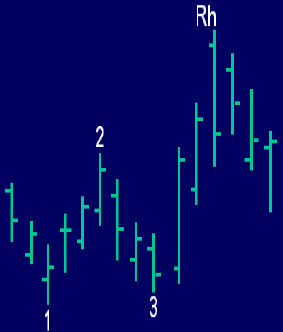In This Article, we want to discover :
- The different ways in which the TTE ‘sets up.’
- When to use the TTE.
- What the TTE accomplishes for you.
- Some basics of how to trade the TTE.
The Traders Trick is designed to beat the insiders at their own game, or at the very least to create a level playing field on which we can trade.
The Traders Trick Entry ctd.
When trading 1-2-3 and Ross hook formations, we want to get in ahead of the actual breakout of the #2 point or the point of the hook. If the breakout is real, the result will be significant profits. If the breakout is false, we will have at least covered our costs and taken some profit for our effort.Insiders will often engineer moves aimed at precisely those points where they realize orders are bunched. It is exactly that kind of engineering that makes the TTE possible.
For an insider to be able to stop us from shadowing his moves, he would have to sabotage himself. You’ll see why shortly.
Let’s begin our examination of the TTE.
The TTE
The TTE And 1-2-3
Once a #2 point is in place, we want to buy a violation of the high of any of the correcting bars that form subsequent to the #2 point.
Correcting bars are the bars subsequent to the #2 point, and for TTE purposes are considered to be correcting as long as they make lower highs.
The following provision applies:
1. There must be sufficient room between our entry price and the #2 point for us to be able to cover costs and take at least some profit.
By insisting that there be enough room to cover costs and take some profit, we accomplish two things:
• 1. We get paid to trade.
• 2. If the breakout proves to be false, we will still have had a winning trade and have traded for free.
The area between the first dashed line and the #2 point must allow enough room to cover costs and take a profit. If not, then the TTE may occur on any of the two subsequent price bars, if there are any subsequent bars.
By covering costs and taking a profit prior to prices reaching #2, we in effect get a free trade. If prices go on well beyond #2, we make a very profitable trade. This assumes trading at least two contracts.
The following provision applies:
2. The 1-2-3 formation must not occur in consolidation. The 1-2-3 formation must occur at the end of a trend.
1-2-3 formations in consolidation areas are meaningless. Consolidation areas have them in both directions.
The following provision applies: 3. With only one exception, there cannot be more than 3 bars of correction prior to prices moving toward the #2 point.
A violation of the high of the first bar of correction gives the greatest percentage chance of the move continuing beyond the #2 point, but has the least likelihood of having room to cover costs and take a profit.
A violation of the high of the second bar of correction gives a lower percentage chance of the move continuing beyond the #2 point, but has a greater likelihood of having room to cover costs and make a profit.
A violation of the high of the third bar of correction gives the lowest percentage chance of the move continuing beyond the #2 point, but has the greatest likelihood of having room to cover costs and take a profit.
Beyond 3 bars of correction, the odds begin to favor consolidation, and so there is no reason to attempt the TTE. We said there is an exception to this rule. It begins on the next slide.
Next : Traders Trick Entry Part 2
















Post a Comment